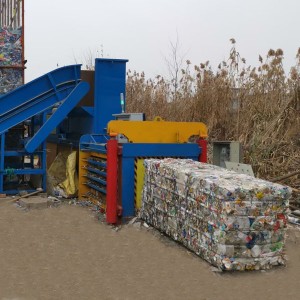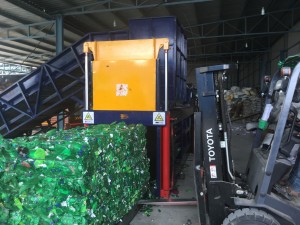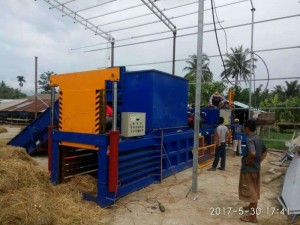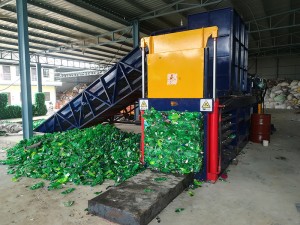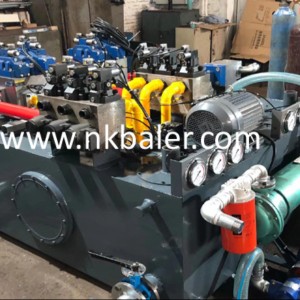Manual Baler Machine
NKW160BD Manual Baler Machine is a manual binding machine that is mainly used to compress materials such as paper and plastic film into compact blocks. This machine is made of high-quality steel, which makes it sturdy and durable with a long service life. The operation is simple and convenient, just put the material into the compression device and control the compression force and time through the handle or foot pedal to complete the binding work. NKW160BD Manual Baler Machine is suitable for small businesses and household use, it can effectively reduce waste volume and transportation costs, and improve economic efficiency.
The NKW160BD Manual Baler Machine is primarily used for compressing daily waste materials such as paper, plastic films, cardboard, aluminum cans, PET bottles, HDPE containers and other soft packaging materials. In addition, it is also suitable for compressing waste paper, steel pipes, steel coils, household chemicals, medical supplies, oils and hair products. The machine is manually operated and does not require power, making it very convenient to move around. It comes with two wheels and can be easily used in different locations. By using this binding machine, the volume of waste can be effectively reduced and transportation costs can be reduced, thereby improving economic efficiency.

| Model | NKW160BD |
| Hydraulic power | 160Ton |
| Cylinder size | Ø280 |
| Bale size(W*H*L) | 1100*1250*1700mm |
| Feed opening size(L*W) | 2000*1100mm |
| Bale density | 600-650Kg/m3 |
| Capability | 6-8T/hour |
| Bale line | 7Line /Manual strapping |
| Power/ | 37.5KW/50HP |
| Out-bale way | Disposable bag out |
| Bale-wire | 6#/8#*7 PCS |
| Machine weight | 19000KG |
| Conveyor | 12000mm*2000mm (L*W) .4.5KW |
| Conveyor weight | 5000kg |
| Cooling system | Water cooling |




A waste paper baling press machine is a piece of machinery used for recycling paper waste into bales. It typically consists of a series of rollers that transport the paper through a series of heated and compressed chambers, where the paper is compacted into bales. The bales are then separated from the residual paper waste, which can be recycled or reused as other paper products.
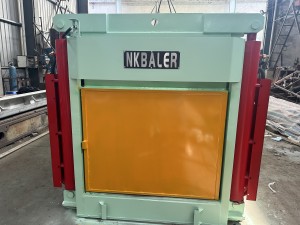
Waste paper baling press machines are commonly used in industries such as newspaper printing, packaging, and office supplies. They help to reduce the amount of waste sent to landfills and promote sustainable practices by recycling valuable resources.
The baling press for waste paper is a machine used in recycling facilities to compact and compress large amounts of paper waste into bales. The process involves feeding the waste paper into the machine, which then uses rollers to compress the material and form it into bales. Baling presses are commonly used in recycling centers, municipalities, and other facilities that handle large volumes of waste paper. They help to reduce the amount of waste sent to landfills and promote sustainable practices by recycling valuable resources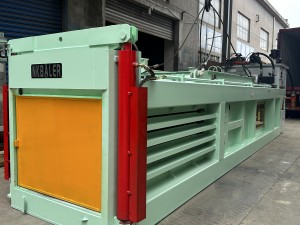
A waste paper baler is a machine used to compact and compress large amounts of waste paper into bales. The process involves feeding the waste paper into the machine, which then uses rollers to compress the material and form it into bales. Waste paper balers are commonly used in recycling centers, municipalities, and other facilities that handle large volumes of waste paper. They help to reduce the amount of waste sent to landfills and promote sustainable practices by recycling valuable resources.as more information ,pls visit us :https://www.nkbaler.com/
waste paper baling press is a machine used to compact and compress large amounts of waste paper into bales. The process involves feeding the waste paper into the machine, which then uses heated rollers to compress the material and form it into bales. Waste paper baling presses are commonly used in recycling centers, municipalities, and other facilities that handle large volumes of waste paper. They help to reduce the amount of waste sent to landfills and promote sustainable practices by recycling valuable resources.
Waste paper baling press machine is a piece of equipment used to recycle waste paper into bales. It is an essential tool in the recycling process, as it helps to reduce the amount of waste sent to landfills and promote sustainable practices by recycling valuable resources. In this article, we will discuss the working principle, types of waste paper baling press machines, and their applications.
The working principle of waste paper baling press machine is relatively simple. The machine consists of several compartments where the waste paper is fed into. As the waste paper moves through the compartments, it is compacted and compressed by heated rollers, which form the bales. The bales are then separated from the residual paper waste, which can be recycled or reused as other paper products.
Waste paper baling press machines are widely used in industries such as newspaper printing, packaging, and office supplies. They help to reduce the amount of waste sent to landfills and promote sustainable practices by recycling valuable resources. In addition, they can also help to save energy and reduce costs for businesses that use paper products.
One of the key benefits of using a waste paper baling press machine is that it can help to improve the quality of the recycled paper. By compacting the waste paper into bales, it becomes easier to transport and store, reducing the risk of damage and contamination. This makes it easier for businesses to recycle their waste paper and ensures that they are able to produce high-quality paper products

In conclusion, waste paper baling press machines are an essential tool in the recycling process. They help to reduce the amount of waste sent to landfills and promote sustainable practices by recycling valuable resources. There are two main types of waste paper baling press machines: hot-air and mechanical, and they are widely used in industries such as newspaper printing, packaging, and office supplies. By using a waste paper baling press machine, businesses can improve the quality of their recycled paper and reduce their environmental impact.









